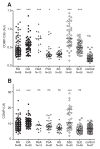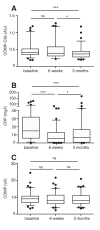Serum COMP-C3b complexes in rheumatic diseases and relation to anti-TNF-α treatment
- PMID: 22264230
- PMCID: PMC3392805
- DOI: 10.1186/ar3694
Serum COMP-C3b complexes in rheumatic diseases and relation to anti-TNF-α treatment
Abstract
Introduction: Cartilage oligomeric matrix protein (COMP) is found at elevated concentrations in sera of patients with joint diseases such as rheumatoid arthritis (RA) and osteoarthritis (OA). We recently showed that COMP activates complement via the alternative pathway and that COMP-C3b complexes are present in sera of RA patients, but not in healthy controls. We now set out to elaborate on the information provided by this marker in a variety of diseases and larger patient cohorts.
Methods: COMP-C3b levels in sera were measured by using an enzyme-linked immunosorbent assay (ELISA) capturing COMP and detecting C3b. Serum COMP was measured by using ELISA.
Results: COMP-C3b levels were significantly elevated in patients with RA as well as in systemic lupus erythematosus (SLE), compared with healthy controls. SLE patients with arthritis had significantly higher COMP-C3b levels than did those without. COMP-C3b was furthermore elevated in patients with ankylosing spondylitis (AS), psoriatic arthritis (PsA), reactive arthritis, systemic sclerosis, and OA. COMP-C3b did not correlate with COMP in any of the patient groups. COMP-C3b correlated with disease activity in RA, but not in other diseases. COMP-C3b levels in RA patients decreased on treatment with tumor necrosis factor (TNF)-α inhibitors, whereas the levels increased in patients with AS or PsA. The changes of COMP-C3b did not parallel the changes of C-reactive protein (CRP).
Conclusions: COMP-C3b levels are elevated in several rheumatologic diseases and correlate with inflammatory measures in RA. COMP-C3b levels in RA decrease during TNF-α inhibition differently from those of CRP, suggesting that formation of COMP-C3b relates to disease features not reflected by general inflammation measures.
Figures




Similar articles
-
[Cartilage oligomeric matrix protein (COMP): the role of a non-collagen cartilage matrix protein as a marker of disease activity and joint destruction in patients with rheumatoid arthritis and osteoarthritis].Z Rheumatol. 1999 Apr;58(2):79-87. doi: 10.1007/s003930050156. Z Rheumatol. 1999. PMID: 10408068 German.
-
Regulation of complement by cartilage oligomeric matrix protein allows for a novel molecular diagnostic principle in rheumatoid arthritis.Arthritis Rheum. 2010 Dec;62(12):3574-83. doi: 10.1002/art.27720. Arthritis Rheum. 2010. PMID: 20737467 Free PMC article.
-
Cartilage oligomeric matrix protein in serum in systemic lupus erythematosus and knee osteoarthritis. Preliminary communication.Rheumatol Int. 2005 Jun;25(5):373-8. doi: 10.1007/s00296-004-0581-7. Epub 2005 Mar 1. Rheumatol Int. 2005. PMID: 15739097
-
Cartilage oligomeric matrix protein level in rheumatic diseases: potential use as a marker for measuring articular cartilage damage and/or the therapeutic efficacy of treatments.Ann N Y Acad Sci. 2007 Jun;1108:398-407. doi: 10.1196/annals.1422.041. Ann N Y Acad Sci. 2007. PMID: 17894003 Review.
-
Structural damage in rheumatoid arthritis, psoriatic arthritis, and ankylosing spondylitis: traditional views, novel insights gained from TNF blockade, and concepts for the future.Arthritis Res Ther. 2011 May 25;13 Suppl 1(Suppl 1):S4. doi: 10.1186/1478-6354-13-S1-S4. Arthritis Res Ther. 2011. PMID: 21624183 Free PMC article. Review.
Cited by
-
The C-type lectin of the aggrecan G3 domain activates complement.PLoS One. 2013 Apr 15;8(4):e61407. doi: 10.1371/journal.pone.0061407. Print 2013. PLoS One. 2013. PMID: 23596522 Free PMC article.
-
Serum Glycoproteome Profiles for Distinguishing Intestinal Fibrosis from Inflammation in Crohn's Disease.PLoS One. 2017 Jan 23;12(1):e0170506. doi: 10.1371/journal.pone.0170506. eCollection 2017. PLoS One. 2017. PMID: 28114331 Free PMC article.
-
Proteomic profiling of serum samples from chikungunya-infected patients provides insights into host response.Clin Proteomics. 2013 Oct 14;10(1):14. doi: 10.1186/1559-0275-10-14. Clin Proteomics. 2013. PMID: 24124767 Free PMC article.
-
Cartilage oligomeric matrix protein (COMP) in rheumatoid arthritis and its correlation with sonographic knee cartilage thickness and disease activity.Clin Rheumatol. 2017 Dec;36(12):2683-2688. doi: 10.1007/s10067-017-3817-0. Epub 2017 Sep 9. Clin Rheumatol. 2017. PMID: 28889184
-
Proteinases and their receptors in inflammatory arthritis: an overview.Nat Rev Rheumatol. 2018 Mar;14(3):170-180. doi: 10.1038/nrrheum.2018.17. Epub 2018 Feb 8. Nat Rev Rheumatol. 2018. PMID: 29416136 Review.
References
-
- Saxne T, Månsson B, Heinegård D. Biomarkers for Cartilage and Bone in Rheumatoid Arthritis. 2. Oxford: Oxford University Press; 2006.
-
- Hesselstrand R, Kassner A, Heinegård D, Saxne T. COMP: a candidate molecule in the pathogenesis of systemic sclerosis with a potential as a disease marker. Ann Rheum Dis. 2008;67:1242–8. - PubMed
-
- Oldberg A, Antonsson P, Lindblom K, Heinegård D. COMP (cartilage oligomeric matrix protein) is structurally related to the thrombospondins. J Biol Chem. 1992;267:22346–50. - PubMed
Publication types
MeSH terms
Substances
LinkOut - more resources
Full Text Sources
Other Literature Sources
Medical
Research Materials
Miscellaneous

